The Storming of the Tuileries
The royal family had lived at the Tuileries Palace since October 1789, when a large crowd had marched on Versailles and demanded that the king live in Paris. The Tuileries had seen better days, particularly during the reign of Louis XIV; Versailles, however, had been the preeminent royal residence since the Sun King had it built. 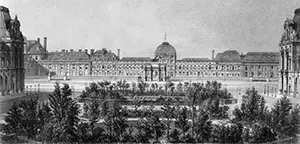
The king continued to hold court and entertain, but he wasn't free to leave. He was the target at times of verbal abuse; certainly, many more radical people wanted him gone as a member of authority. On Feb. 28, 1791, a few hundred noblemen surrounded the king in the palace. They were armed, in response to rumors that another crowd was going to descend on the king and threaten him. In fact, another crowd did materialize, in the form of a group of sans-culottes, radical commoners who championed republicanism. The king, along with the head of the National Guard the Marquis de Lafayette, kept the peace and convinced both crowds to disperse. The events came to be known as the Day of Daggers. A few weeks later, another mob gathered outside the palace and prevented the king from going to his summer residence at Saint-Cloud. This, in the king's mind, all but confirmed that he was effectively a prisoner in Paris. 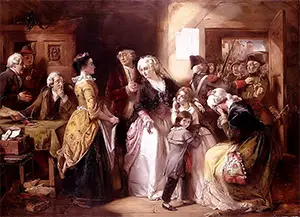
For some time, many leaders of the Revolution had feared that the king would try to flee the country. He did just that, on the evening of June 20, 1791. He had taken that action as a result of a secret meeting between representatives of Austria, Sardinia, Spain, and Switzerland that had resulted in a pledge of invasion in order to rescue Louis XVI from his subjects. The king refused such assistance but did accept the offer of safety at Montmédy that was extended by General Bouillé. Thus it was that king and family traveled by carriage on the road to Chãlons, toward Montmédy. The National Constituent Assembly, having discovered the king's absence, announced that it had assumed executive power and encouraged the army to take an oath to defend the Assembly, not the king. Louis, meanwhile, revealed himself to his subjects at Varennes on June 21 and was arrested and returned to Paris. The Assembly finally achieved what it had set out to do at the beginning, creating the Constitution of 1791. The king had agreed to become a constitutional monarch, and the Constitution had not given him much power. Having served its purpose, the Assembly met for the last time on Oct. 1, 1791. Replacing it was the Legislative Assembly. One power that the king did have under the new Constitution was the power to veto legislation. He used that veto power on two occasions in the last two months of 1791, angering many who still saw him as a relic of states past. France had gone to war with Austria in April 1792, and early results did not bode well for French troops, who lost battle after battle and had to fend off an invasion by Prussian troops. The French force had turned out to be ill prepared for such a war. 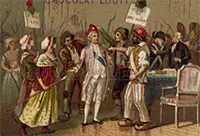
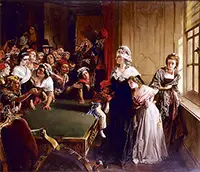
In June 1792, tempers boiled over again, as an armed crowd marched into the Tuileries and demanded that the king abrogate his veto power. A small number of protesters stormed into the king's quarters; one of the protesters had an axe and moved toward the king. Louis XVI calmed the aggressors by listening to their demands and promising to consider them. He sealed his promise by donning a red liberty cap that was the symbol of republicanism. A similar scene played out in another room, when another crowd surrounded the queen and her children and one of the crowd placed a red hat on the head of the crown prince. The next month, the war flared up again, as the Duke of Brunswick issued the Brunswick Manifesto, promising to devastate Paris if any harm came to the royal family. This led to the spreading of rumors in Paris that the king would again flee the country, even be rescued by a secret raid or a full-blown invasion of the capital. As a result, a determined number of lawmakers and others developed a plan to seize the royal family. The first stage took place on August 9. A large crowd occupied the Hôtel de Ville and seized control of the Paris Commune, the city's municipal government. The next day, an even larger crowd, swelled by members of the National Guard who wanted a true republic, marched on the Tuileries Palace. What should have happened is not what happened. As a matter of course, guarding the royal palace was a large assortment of armed soldiers: members of the National Guard, the Swiss Guard, and local police. After the seizure of the Commune, many of the National Guard and local police defending the Tuileries left their posts in the night. 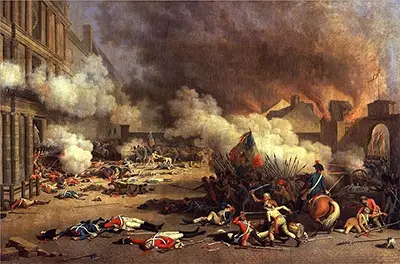
At dawn on August 10, a large crowd of people, many armed with crude weapons, had gathered outside the royal palace. Seeing this, the king and his family took refuge in the building that housed the Legislative Assembly, the country's supreme lawmaking authority. Meanwhile, the crowd had breached the main gates and were doing battle with the Swiss Guard. The battle raged for hours, until the Swiss Guard ran out of ammunition. The king ordered the Swiss Guard to stop their defense. The crowd then descended into savageness that resulted in the deaths of more than 600 Swiss Guard troops and the capture of 250 more. The victorious crowd then surrounded the Assembly chamber and demanded the abolition of the monarchy and, further, the dissolution of the Assembly itself. The Assembly did so, replacing the king with a five-man council and giving orders for the formation of what became the National Convention. The crowd did not harm the king or his family but did imprison them in the Temple. |
|
Social Studies for Kids
copyright 2002–2024
David White




